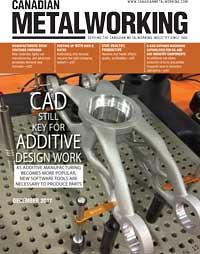Sales and Marketing Director
- FMA
- The Fabricator
- FABTECH
- Canadian Metalworking
Keeping up with high Q rates
Automating chip removal requires the right conveying system
- By Mike Hook
- December 15, 2017
- Article
- Metalworking

Drag conveyors are installed at floor level for transfer of material from the machine table to the conveyor.
For today’s industrial manufacturing applications, it’s all about output. The goal is to machine as many parts as possible in the shortest amount of time to maximize profitability.
In industries that regularly machine huge blocks of metal down to a part that’s approximately 10 to 20 per cent of the size and weight of the original piece, that process generates high volumes of metal chips, shavings, grindings, and turnings.
High-speed machining centres can’t simply let all that scrap pile up on the manufacturing floor. Manually removing it with shovels isn’t (or shouldn’t be) a viable option, both for the health and safety risks, as well as the fact that more material is being generated than workers can keep up with.
These facilities need automated equipment like conveying systems that are designed to efficiently and expediently move these massive amounts of material out of the cutting machines and the work zone to an area where they can be processed, disposed of, or recycled. The coolant the cutting machines use needs to be dealt with as well, and its presence is one of the factors that affect the composition of the scrap material, which in turn dictates the type of conveying equipment that is best suited to move it.
High Speeds = High Chip Volume
To make an informed decision about a conveying system for metal scrap, it’s important to understand how high-speed, high-volume machine shops operate. Most have several machines, so if they set a 3,000-lb. block of aluminum on each machine and reduce it to a 300-lb. part, that leaves 2,700 lbs. of aluminum shavings per manufactured part.
That material must be removed from the tables as quickly as possible to ensure effective machining, a clean work area for surface finish, and minimal lag time before the next block is set in place and the process begins again.
Heavy-flow flood coolant usually is used to spray the tool in high-rate applications because it serves a dual purpose: It sends the scrap away from the tool, and more coolant means less heat, which allows for faster cutting and longer tool life. Some shops have considered the option of using less coolant – in which case a vacuum-type system is used to pull the drier chips off the tool – but that is counterintuitive to most organizations’ attempts to get maximum profitability and longevity from their machines. While reduced coolant use does equate to less cost, it typically requires the machining process to be slower, which results in less output.
Because of the size of some milling machines and the sheer tonnage of scrap they generate, the amount of floor space for waste material to accumulate is limited. Factor in the assumed use of flood coolant and it’s easy to see why high-rate applications require a multifaceted conveying system capable of handling large volumes of scrap and fluid in an efficient, automated fashion that eliminates the safety risks associated with shovelling or sweeping chips and turnings.
Several conveyor options exist, with each having advantages and disadvantages depending on the application. Four main factors that should influence any conveying system decision are the type of material, the chip profile, the type of coolant used, and the amount of coolant used.
Steel-Belt System
The simplest system is a steel-belt conveyor. More versatile than other types of material handling equipment, the steel-belt conveyor can handle most types of wet or dry metal scrap – from bushy material to chips and turnings – in any volume, and in a variety of conveyor paths.

Steel-belt conveyors can handle most types of wet or dry metal scrap in any volume, and in a wide variety of conveyor paths.
A hinged steel belt is the industry standard, but different types of belts can be used in these conveyors depending on the application, including:
- Beaded pan for high-heat and heavy-wear applications.
- Pivot belt for small, thin chips and sticky scrap.
- Bucket belt for conveying highly flowable product up a steep incline.
Steel-belt conveyors can move a high volume of material consistently, even in piles and high surges, but they aren’t the best way to deal with high volumes of liquid flow. They have a lot of moving parts that wear quickly and require maintenance when chips and fine particulate enter the mechanism.
Drag Conveyor
The next option is a drag conveyor, which is designed for conveying and elevating the most difficult, most abrasive wet or dry materials. These conveyors can be installed at floor level for easy transfer of material from the machine table to the conveyor. They also have multiple infeed and discharge points to fit specific applications, and they can be customized with coolant pumps for integration with a chip and fluid filtration system.
Drag conveyors can handle a higher volume of coolant than steel-belt systems, and they have fewer moving parts. They are not ideal for processes that send cutoffs, bar ends, tooling pieces, and other solid materials or parts through the conveyor, and they are not conducive to moving longer, stringier drilling chips or turnings that can twist up and bundle.
Trough-Style Equipment
Trough-type conveyors are workhorses that transfer all types of metal chips, fines, and turnings; wet or dry bushy wads; and tramp metal solids. Their liquid-tight trough construction makes them suitable for high-volume coolant flow applications, and their flush-with-the-floor orientation allows both material and coolant to run directly into the conveyor with minimal manual interaction or slowdown of the process.
These conveyors typically have a reciprocating ram that either floats or is mounted to the bottom of the trough. Floating rams collect high volumes of turnings and chips and as much fluid as is required. They can even pass small chunks of solid material that end up in the trough.
While this conveyance method is a little slower than others, it moves a higher volume of material, so it can accomplish the same results as a faster-moving conveyor. Component wear can be a concern with these conveyors because of metal-on-metal contact on the bottom of the trough as the ram assembly reciprocates.
Mounted rams are lifted off the bottom of the trough to allow fluid and fine particulate to flow through the conveyor along the bottom of the trough without the excess wear.
In applications where there is a lot of fine particulate moving through the conveyor, the floating system may be preferable because it scrapes along the bottom of the trough and will do a more thorough job of cleaning out the particulate. In mounted-ram equipment, because the ram assembly is suspended slightly above the bottom of the trough, some amount of material will always be present at the bottom.
Automating the chip removal process is a must for metalworking operations with high Q rates. By using conveyors to quickly transfer scrap and coolant from machines to a central collection area for separation and processing, machine shops can produce more parts with less downtime between jobs, create more value for their scrap, and increase revenue by recycling coolant.

A Harpoon® trough conveyor has a floating ram assembly in the trough that reciprocates back and forth, collecting a large volume of chips and fluid.
Not all conveying systems are suited for every scrap-handling application, however. Taking the time to understand and assess the advantages and disadvantages of each available system as they apply to each operation – ideally with the input of a trusted, experienced supplier – will help guarantee the best ROI.
Mike Hook is national sales manager for Prab, 800-968-7722, www.prab.com.
About the Author
subscribe now


Keep up to date with the latest news, events, and technology for all things metal from our pair of monthly magazines written specifically for Canadian manufacturers!
Start Your Free Subscription- Industry Events
MME Saskatoon
- May 28, 2024
- Saskatoon, SK Canada
CME's Health & Safety Symposium for Manufacturers
- May 29, 2024
- Mississauga, ON Canada
DiPaolo Machine Tools Open House 2024
- June 4 - 5, 2024
- Mississauga, ON Canada
FABTECH Canada
- June 11 - 13, 2024
- Toronto, ON Canada
Zoller Open House & Technology Days 2024
- June 12 - 13, 2024
- Ann Arbor, MI




















